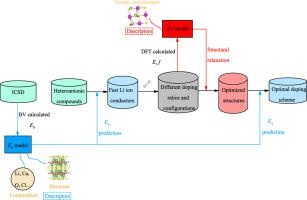Journal of Materiomics ( IF 9.4 ) Pub Date : 2022-02-25 , DOI: 10.1016/j.jmat.2022.02.010 Yuqi Wang 1, 2 , Siyuan Wu 1, 2 , Wei Shao 3 , Xiaorui Sun 1, 2 , Qiang Wang 3 , Ruijuan Xiao 1, 2 , Hong Li 1, 2

|
Fast ion conductor materials screening based on high-throughput calculations involves enormous computing tasks. The process usually includes structural optimization, energy calculation, charge analysis and ionic migration performance estimation. The first one involves looking for the equilibrium atomic positions in huge amount of candidate compounds or derivative structures, and the computational cost is always high because of the task-intensive features. The last one relates to the kinetic problems, for which the time-consuming transition state theory and the molecular dynamics are the main simulation methods. In this work, two predictive models, ionic migration activation energy model and structural optimization model, are developed based on machine learning (ML) techniques to accelerate the process of estimating activation energy and relaxing the doped crystal structures, respectively. By training 3136 energy barrier data calculated by bond valence (BV) method, an ionic migration activation energy model (Ea model) with mean absolute error (MAE) of 0.26 eV on testing data set is obtained. We apply this model and filter LiBiOS as a promising fast Li+ conductor from 49 Li-containing hetero-anionic compounds. Although the model-predicted result shows relatively low energy barrier, further analysis indicates that the high carrier formation energy restricts the ionic transportability. Therefore, we substitute fractional Li+ with Mg2+ in LiBiOS to relieve the large difficulty of forming carriers in the structure. In order to fast explore the optimal doping scheme, we develop the structural optimization model (E-f model) containing the ML-based energy and force prediction to accelerate the structural optimization under various Li Mg ratio and doping configurations. Decent doping scheme Li1-2xMgxBiOS (x = 0.1875) shows much better Li+ migration performance compared with LiBiOS without substitution. This method of screening fast ion conductor materials and finding optimal doping scheme will extremely accelerate materials explorations.
Mg ratio and doping configurations. Decent doping scheme Li1-2xMgxBiOS (x = 0.1875) shows much better Li+ migration performance compared with LiBiOS without substitution. This method of screening fast ion conductor materials and finding optimal doping scheme will extremely accelerate materials explorations.
中文翻译:

快速离子导体材料筛选和最佳掺杂方案探索的加速策略
基于高通量计算的快速离子导体材料筛选涉及巨大的计算任务。该过程通常包括结构优化、能量计算、电荷分析和离子迁移性能估计。第一个涉及在大量候选化合物或衍生结构中寻找平衡原子位置,由于任务密集型特征,计算成本总是很高。最后一个涉及动力学问题,其中耗时的过渡态理论和分子动力学是主要的模拟方法。在这项工作中,两个预测模型,离子迁移活化能模型和结构优化模型,是基于机器学习 (ML) 技术开发的,以分别加速估计活化能和放松掺杂晶体结构的过程。通过训练键价(BV)方法计算的3136个能垒数据,建立离子迁移活化能模型(获得了在测试数据集上平均绝对误差(MAE)为 0.26 eV 的模型)。我们应用该模型并从 49 种含锂的杂阴离子化合物中过滤出 LiBiOS 作为有前途的快速 Li +导体。尽管模型预测的结果显示出相对较低的能垒,但进一步分析表明,高载流子形成能限制了离子可传输性。因此,我们在LiBiOS中用Mg 2+代替部分Li +以缓解结构中形成载流子的大困难。为了快速探索最佳掺杂方案,我们开发了结构优化模型(E - f模型)包含基于 ML 的能量和力预测,以加速各种 Li  Mg 比例和掺杂配置下的结构优化。与没有替代的 LiBiOS 相比,体面的掺杂方案 Li 1-2 x Mg x BiOS ( x = 0.1875) 显示出更好的 Li +迁移性能。这种筛选快离子导体材料并找到最佳掺杂方案的方法将极大地加速材料探索。
Mg 比例和掺杂配置下的结构优化。与没有替代的 LiBiOS 相比,体面的掺杂方案 Li 1-2 x Mg x BiOS ( x = 0.1875) 显示出更好的 Li +迁移性能。这种筛选快离子导体材料并找到最佳掺杂方案的方法将极大地加速材料探索。



























 京公网安备 11010802027423号
京公网安备 11010802027423号